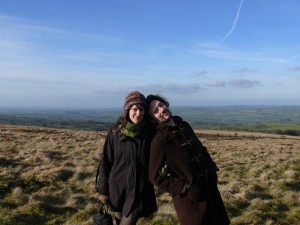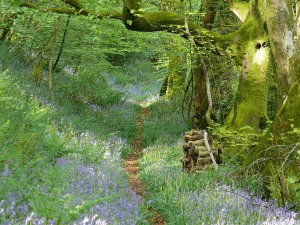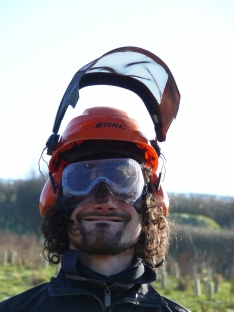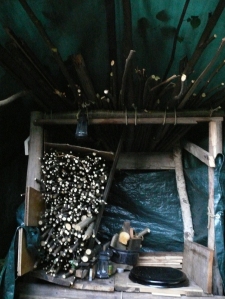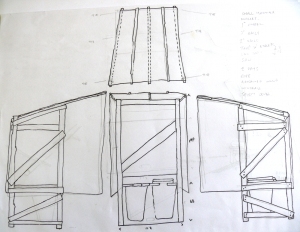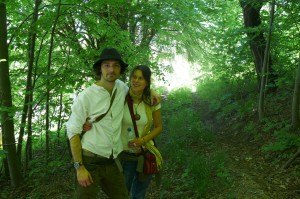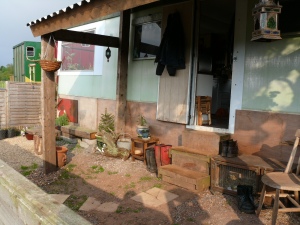This blog exists to provide information for anyone wishing to embark on a similar project. As mentioned in our first post, we would not be doing this without the wealth of information we have found online that has inspired us to take control of our lives and take active steps to becoming self sufficient and closer to nature.
This particular post is essentially a bibliography, It keeps growing and as we find more inspirational books and websites we will keep updating it ! We hope this is useful. we have thrown in a few more photographs of Maitreya to break up the text.
a quiet moment on our first trip to Maitreya

websites
all websites are shown in the categorized long list on the right of the blog. However we feel it is worth mentioning some really cracking ones that we always return to. We thank all the authors of these websites for their constant inspiration, taking the time to write a (non advertised) website is a wholly selfless act, this is what the internet exists for !
No matter where we stray online, we always find our way back to Simon Dales low impact woodland home and Tony Wrench’s that roundhouse for assurance and information. We also follow the Lamma’s eco-community closely. Since this project is happening now and is evolving constantly.
The articles and fact sheets put out by the low impact living initiative are fantastic, very easy to follow and generously described. The website dew drop provides brilliant information on water purification, finding springs and how to begin ‘pioneering’ a water system from underground streams to tap water.
Some great ‘how to’ guides can be found at the steward community woodland a great source of information for anyone living in or near woodland. Ianto Evans (a self builder) has published a book on very efficient wood burning stoves and his website rocket stoves gives away a few fundimentals from his book.
If this is not enough to get you dashing out to buy some hand tools and a tent then take a look at the long list on the right and dip in to a few of the books below – and keep checking back ! for even when we have our small holding established we will still be learning and finding new things to look at.
superb view across the hills on our first morning

books
We recently bought two books by Lloyd Kahn (author of counterculture book Shelter) named Homework and Builders, both are full to bursting with photographs of self built houses and dwellings with interviews and practical information for anyone wishing to ‘take up thy hammer and build’ probably the best £30 we have spent this year !
We are amassing a small library of books on growing, building and permaculture and would like to make shorter work of the research we have made in finding them. All the books listed below are our favorite reference books, we keep coming back to them and have shaped the way we approach our project.
building :
HOMEWORK by Lloyd Kahn : isbn 978 0 936070 33 9 – examples of owner / builders and their homes, with plans and schematics and plenty of very good information on building naturally, remotely and on small as well as large scale,
BUILDERS by Lloyd Kahn : isbn 978 0 936070 43 8 – same as above but focusing on the pacific west coast of USA
BUILDING WITH COB by A Weismann / K Brice : isbn 978 1 903 998 72 4 – a step by step guide to building with cob, this will be our constant companion while building our own home.
BUILDING WITH STRAW BALES by Barbara Jones : isbn 978 1 900 322 51 5 – focusing on outreaching to the building industry, can be used as a step by step guide for building with straw bale, good companion book to the above.
GREEN WOODWORK by Mike Abbott : isbn 0 946819 18 1 – great introduction to woodwork, plans for a pole lathe ( no electricity ) and great resource for the novice on types of wood and their uses.
smoking our socks over the fire
 gardening :
gardening :
ORGANIC GARDENING by Charles Dowding : isbn 978 1 903998 91 5 – introduction to the ‘no dig way’ includes plans for raised vegetable beds, fantastic reference book, read this book even before starting a garden.
ASK MOTHER NATURE by Ellen Vande Visse : isbn 978 1 84409 163 8 – a conscious gardeners guide, whimsical and full of useful tips especially on companion planting and composting, explains how to warn plants before cutting and harvesting
ALLOTMENT MONTH BY MONTH by Alan Buckingham : 978 1 4053 4085 4 – very clear year planner for managing a veg plot, really useful reference book, just ignore the advise about spraying things with chemicals
THE PERMACULTURE GARDEN by Graham Bell : isbn 0 7225 2783 7 – full of very good clear diagrams focusing on improvements and establishing permaculture on a local level, good easy reading
wood campsite, summer 2011

sustainable living :
21ST CENTURY SMALLHOLDER by Paul waddington : isbn 978 1 905 81116 8 – how to smallhold in a variety of locations from city centre to isolation, describes animal rearing and veg growing in a realistic fashion.
SIMPLY SUSTAINABLE HOMES by Tim Pullen isbn : 978 1 905959 044 – good beginners overview of building sustainable homes covers solar, wind, hydro, different building techniques and compares them realistically to each other.
THE OFF GRID HANDBOOK by Alan & Gill Bridgewater isbn : 978 1 84773 158 6 – Similar to above but gives example of seven types of off grid energy applied in urban, rural and isolated scenarios, very good for novices.
THE MONEYLESS MAN by Mark Boyle isbn : 978 1 85168 754 1 – Mark Boyles story of living for a year without money. Includes useful information on how to survive on very little and reinforces the maxim ‘necessity is the mother of invention’. Covers a wide range of topics including freeconomy, transition movement, foraging, off grid living and pay it forward.
other :
WABI SABI by Leonard Koren : isbn 978 0 9814846 0 0 – forgotten how many times I have read this one, it is wearing out ! brilliant description of a difficult Japanese concept – how to appreciate the beauty in the simple, the everyday, the natural and the dilapidated. It is a holistic aesthetic sensibility summarized perfectly in a sweet little 90 page book. I never travel without it. (xmatthew)
surreal encounter with a concrete Pac-Man


